[English] 日本語
 Yorodumi
Yorodumi- PDB-3jq0: Crystal structure of SusD superfamily protein (YP_001299712.1) fr... -
+ Open data
Open data
- Basic information
Basic information
| Entry | Database: PDB / ID: 3jq0 | ||||||
|---|---|---|---|---|---|---|---|
| Title | Crystal structure of SusD superfamily protein (YP_001299712.1) from Bacteroides vulgatus ATCC 8482 at 1.13 A resolution | ||||||
 Components Components | SusD superfamily protein | ||||||
 Keywords Keywords | SUGAR BINDING PROTEIN / YP_001299712.1 / SusD superfamily protein / Structural Genomics / Joint Center for Structural Genomics / JCSG / Protein Structure Initiative / PSI-2 / RagB / SusD and hypothetical proteins / unknown function | ||||||
| Function / homology |  Function and homology information Function and homology information | ||||||
| Biological species |  Bacteroides vulgatus ATCC 8482 (bacteria) Bacteroides vulgatus ATCC 8482 (bacteria) | ||||||
| Method |  X-RAY DIFFRACTION / X-RAY DIFFRACTION /  SYNCHROTRON / SYNCHROTRON /  SAD / Resolution: 1.13 Å SAD / Resolution: 1.13 Å | ||||||
 Authors Authors | Joint Center for Structural Genomics (JCSG) | ||||||
 Citation Citation |  Journal: To be published Journal: To be publishedTitle: Crystal structure of SusD superfamily protein (YP_001299712.1) from Bacteroides vulgatus ATCC 8482 at 1.13 A resolution Authors: Joint Center for Structural Genomics (JCSG) | ||||||
| History |
|
- Structure visualization
Structure visualization
| Structure viewer | Molecule:  Molmil Molmil Jmol/JSmol Jmol/JSmol |
|---|
- Downloads & links
Downloads & links
- Download
Download
| PDBx/mmCIF format |  3jq0.cif.gz 3jq0.cif.gz | 253.4 KB | Display |  PDBx/mmCIF format PDBx/mmCIF format |
|---|---|---|---|---|
| PDB format |  pdb3jq0.ent.gz pdb3jq0.ent.gz | 201 KB | Display |  PDB format PDB format |
| PDBx/mmJSON format |  3jq0.json.gz 3jq0.json.gz | Tree view |  PDBx/mmJSON format PDBx/mmJSON format | |
| Others |  Other downloads Other downloads |
-Validation report
| Summary document |  3jq0_validation.pdf.gz 3jq0_validation.pdf.gz | 467.2 KB | Display |  wwPDB validaton report wwPDB validaton report |
|---|---|---|---|---|
| Full document |  3jq0_full_validation.pdf.gz 3jq0_full_validation.pdf.gz | 473.1 KB | Display | |
| Data in XML |  3jq0_validation.xml.gz 3jq0_validation.xml.gz | 33.6 KB | Display | |
| Data in CIF |  3jq0_validation.cif.gz 3jq0_validation.cif.gz | 51.3 KB | Display | |
| Arichive directory |  https://data.pdbj.org/pub/pdb/validation_reports/jq/3jq0 https://data.pdbj.org/pub/pdb/validation_reports/jq/3jq0 ftp://data.pdbj.org/pub/pdb/validation_reports/jq/3jq0 ftp://data.pdbj.org/pub/pdb/validation_reports/jq/3jq0 | HTTPS FTP |
-Related structure data
| Similar structure data | |
|---|---|
| Other databases |
- Links
Links
- Assembly
Assembly
| Deposited unit | 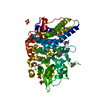
| ||||||||
|---|---|---|---|---|---|---|---|---|---|
| 1 |
| ||||||||
| Unit cell |
| ||||||||
| Components on special symmetry positions |
| ||||||||
| Details | CRYSTAL PACKING ANALYSIS SUGGESTS THE ASSIGNMENT OF A MONOMER AS THE SIGNIFICANT OLIGOMERIZATION STATE. |
- Components
Components
-Protein , 1 types, 1 molecules A
| #1: Protein | Mass: 57293.695 Da / Num. of mol.: 1 Source method: isolated from a genetically manipulated source Source: (gene. exp.)  Bacteroides vulgatus ATCC 8482 (bacteria) Bacteroides vulgatus ATCC 8482 (bacteria)Strain: ATCC 8482 / DSM 1447 / NCTC 11154 / Gene: BVU_2431, YP_001299712.1 / Plasmid: SpeedET / Production host:  |
|---|
-Non-polymers , 5 types, 842 molecules 








| #2: Chemical | ChemComp-TRS / | ||||||
|---|---|---|---|---|---|---|---|
| #3: Chemical | ChemComp-GOL / #4: Chemical | #5: Chemical | ChemComp-CL / | #6: Water | ChemComp-HOH / | |
-Details
| Has protein modification | Y |
|---|---|
| Sequence details | SEQUENCE THIS CONSTRUCT (RESIDUES 33-524) WAS EXPRESSED WITH A PURIFICATION TAG MGSDKIHHHHHHENLYFQG. ...SEQUENCE THIS CONSTRUCT (RESIDUES 33-524) WAS EXPRESSED WITH A PURIFICATI |
-Experimental details
-Experiment
| Experiment | Method:  X-RAY DIFFRACTION / Number of used crystals: 1 X-RAY DIFFRACTION / Number of used crystals: 1 |
|---|
- Sample preparation
Sample preparation
| Crystal | Density Matthews: 2.34 Å3/Da / Density % sol: 47.55 % |
|---|---|
| Crystal grow | Temperature: 277 K / Method: vapor diffusion, sitting drop / pH: 8 Details: 1.60M (NH4)2SO4, 0.1M TRIS pH 8.0, NANODROP, VAPOR DIFFUSION, SITTING DROP, temperature 277K |
-Data collection
| Diffraction | Mean temperature: 100 K | ||||||||||||||||||||||||||||||||||||||||||||||||||||||||||||||||||||||||||||||||||||||||||||||||||||||||||||||||||||||||||||||||||||||||||||||||||||||||||||||||||||||||
|---|---|---|---|---|---|---|---|---|---|---|---|---|---|---|---|---|---|---|---|---|---|---|---|---|---|---|---|---|---|---|---|---|---|---|---|---|---|---|---|---|---|---|---|---|---|---|---|---|---|---|---|---|---|---|---|---|---|---|---|---|---|---|---|---|---|---|---|---|---|---|---|---|---|---|---|---|---|---|---|---|---|---|---|---|---|---|---|---|---|---|---|---|---|---|---|---|---|---|---|---|---|---|---|---|---|---|---|---|---|---|---|---|---|---|---|---|---|---|---|---|---|---|---|---|---|---|---|---|---|---|---|---|---|---|---|---|---|---|---|---|---|---|---|---|---|---|---|---|---|---|---|---|---|---|---|---|---|---|---|---|---|---|---|---|---|---|---|---|---|
| Diffraction source | Source:  SYNCHROTRON / Site: SYNCHROTRON / Site:  SSRL SSRL  / Beamline: BL12-2 / Wavelength: 0.97936 / Beamline: BL12-2 / Wavelength: 0.97936 | ||||||||||||||||||||||||||||||||||||||||||||||||||||||||||||||||||||||||||||||||||||||||||||||||||||||||||||||||||||||||||||||||||||||||||||||||||||||||||||||||||||||||
| Detector | Type: MARMOSAIC 325 mm CCD / Detector: CCD / Date: May 8, 2009 Details: Flat mirror, vertical and horizontal focussing mirrors | ||||||||||||||||||||||||||||||||||||||||||||||||||||||||||||||||||||||||||||||||||||||||||||||||||||||||||||||||||||||||||||||||||||||||||||||||||||||||||||||||||||||||
| Radiation | Monochromator: Double crystal monochromator / Protocol: SINGLE WAVELENGTH / Monochromatic (M) / Laue (L): M / Scattering type: x-ray | ||||||||||||||||||||||||||||||||||||||||||||||||||||||||||||||||||||||||||||||||||||||||||||||||||||||||||||||||||||||||||||||||||||||||||||||||||||||||||||||||||||||||
| Radiation wavelength | Wavelength: 0.97936 Å / Relative weight: 1 | ||||||||||||||||||||||||||||||||||||||||||||||||||||||||||||||||||||||||||||||||||||||||||||||||||||||||||||||||||||||||||||||||||||||||||||||||||||||||||||||||||||||||
| Reflection | Resolution: 1.13→29.45 Å / Num. obs: 187091 / % possible obs: 91.5 % / Redundancy: 5 % / Biso Wilson estimate: 7.466 Å2 / Rmerge(I) obs: 0.111 / Rsym value: 0.111 / Net I/σ(I): 9.3 | ||||||||||||||||||||||||||||||||||||||||||||||||||||||||||||||||||||||||||||||||||||||||||||||||||||||||||||||||||||||||||||||||||||||||||||||||||||||||||||||||||||||||
| Reflection shell | Diffraction-ID: 1
|
-Phasing
| Phasing | Method:  SAD SAD |
|---|
- Processing
Processing
| Software |
| ||||||||||||||||||||||||||||||||||||||||||||||||||||||||||||||||||||||||||||||||||||||||||||||||||||
|---|---|---|---|---|---|---|---|---|---|---|---|---|---|---|---|---|---|---|---|---|---|---|---|---|---|---|---|---|---|---|---|---|---|---|---|---|---|---|---|---|---|---|---|---|---|---|---|---|---|---|---|---|---|---|---|---|---|---|---|---|---|---|---|---|---|---|---|---|---|---|---|---|---|---|---|---|---|---|---|---|---|---|---|---|---|---|---|---|---|---|---|---|---|---|---|---|---|---|---|---|---|
| Refinement | Method to determine structure:  SAD / Resolution: 1.13→29.45 Å / Cor.coef. Fo:Fc: 0.982 / Cor.coef. Fo:Fc free: 0.979 / Occupancy max: 1 / Occupancy min: 0.28 / SU B: 0.753 / SU ML: 0.016 / Cross valid method: THROUGHOUT / σ(F): 0 / ESU R: 0.027 / ESU R Free: 0.027 SAD / Resolution: 1.13→29.45 Å / Cor.coef. Fo:Fc: 0.982 / Cor.coef. Fo:Fc free: 0.979 / Occupancy max: 1 / Occupancy min: 0.28 / SU B: 0.753 / SU ML: 0.016 / Cross valid method: THROUGHOUT / σ(F): 0 / ESU R: 0.027 / ESU R Free: 0.027 Stereochemistry target values: MAXIMUM LIKELIHOOD WITH PHASES Details: 1. HYDROGENS HAVE BEEN ADDED IN THE RIDING POSITIONS. 2. A MET-INHIBITION PROTOCOL WAS USED FOR SELENOMETHIONINE INCORPORATION DURING PROTEIN EXPRESSION. THE OCCUPANCY OF THE SE ATOMS IN THE ...Details: 1. HYDROGENS HAVE BEEN ADDED IN THE RIDING POSITIONS. 2. A MET-INHIBITION PROTOCOL WAS USED FOR SELENOMETHIONINE INCORPORATION DURING PROTEIN EXPRESSION. THE OCCUPANCY OF THE SE ATOMS IN THE MSE RESIDUES WAS ADJUSTED TO QUENCH THE DIFFERENCE FOURIER DENSITY. 3. GLYCEROL (GOL), SULFATE (SO4), CHLORIDE (CL), AND 2-AMINO-2-HYDROXYMETHYL-PROPANE-1,3-DIOL (TRIS BASE, TRS) MOLECULES FROM THE CRYSTALLIZATION/CRYOPROTECTION SOLUTION ARE MODELED. 4. RAMACHANDRAN OUTLIER RESIDUES 66, 69 AND 440 ARE SUPPORTED BY ELECTRON DENSITY.
| ||||||||||||||||||||||||||||||||||||||||||||||||||||||||||||||||||||||||||||||||||||||||||||||||||||
| Solvent computation | Ion probe radii: 0.8 Å / Shrinkage radii: 0.8 Å / VDW probe radii: 1.4 Å / Solvent model: BABINET MODEL WITH MASK | ||||||||||||||||||||||||||||||||||||||||||||||||||||||||||||||||||||||||||||||||||||||||||||||||||||
| Displacement parameters | Biso max: 54.74 Å2 / Biso mean: 13.075 Å2 / Biso min: 5.43 Å2
| ||||||||||||||||||||||||||||||||||||||||||||||||||||||||||||||||||||||||||||||||||||||||||||||||||||
| Refinement step | Cycle: LAST / Resolution: 1.13→29.45 Å
| ||||||||||||||||||||||||||||||||||||||||||||||||||||||||||||||||||||||||||||||||||||||||||||||||||||
| Refine LS restraints |
| ||||||||||||||||||||||||||||||||||||||||||||||||||||||||||||||||||||||||||||||||||||||||||||||||||||
| LS refinement shell | Resolution: 1.13→1.159 Å / Total num. of bins used: 20
|
 Movie
Movie Controller
Controller


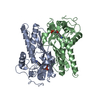
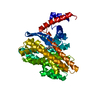
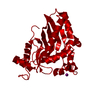

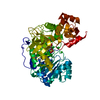

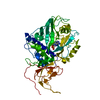
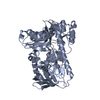

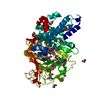
 PDBj
PDBj



